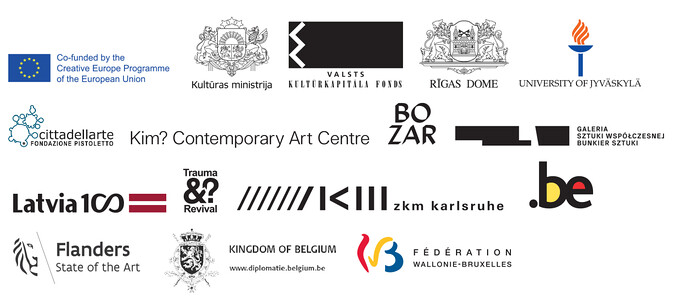An exhibition presented across three contemporary art organizations
Artists: Darja Bajagić, Wojciech Bąkowski, Matei Bejenaru, Piotr Bosacki, Pavel Brăila, Veronika Bromová, Jan Brož, Jiří Černický, Romana Drdová, Habima Fuchs, Matyáš Chochola, Anežka Hošková, Atis Jākobsons, Zsófia Keresztes, Aurora Király, Adrian Kiss, Adam Kokesch, Jiří Kovanda, Piotr Łakomy, Václav Litvan, Pavla Malinová, David Maljkovic, Jimena Mendoza, Gizela Mickiewicz, Marge Monko, Vlad Nancă, Ioana Nemeş, Alice Nikitinova, Richard Nikl, Pakui Hardware, Jasanský & Polák, Julius Reichel, Dragana Sapanjoš, Jiří Skála, Adéla Součková, Petr Štembera, Авдей Тер-Оганьян, Mark Ther, Viktor Timofeev, Jerzy Truszkowski, Anetta Mona Chişa & Lucia Tkáčová, Emöke Vargová, Martin Vongrej, Jana Želibská
Dates and venues
Kim? Contemporary Art Center, Riga. April 20–May 20, 2018
BOZAR Center for Fine Arts, Brussels, June 20–August 19, 2018
At BOZAR the exhibition is presented as a part of Somewhere in Between
Bunkier Sztuki Gallery of Contemporary Art, Krakow, September 21–December 16, 2018
Curator: Michal Novotný
The exhibition Orient is a meditation on the Eastern European identity. As the unifying aspect of this unclear region, it considers the contradictory longing for pride and patriotism, and the simultaneous shame of where we come from. The internalisation of the collapse of the surrounding context, once built upon a social and political utopia. The expectation of catching up with the western capitalist standards, for which the integration into Europe, meaning Western Europe, was so often reduced on both sides. The slipping of the Second World from the frame (1), and hence belonging neither to Europe, nor to the West, nor to “non-Western.”
This exhibition chose the projection of an obviously problematic title (2), to constitute the self-ironic identity of the “East European (br)Other.” Stating the suppressed inferiority complex, as a possible reason for the recent upheaval of nationalism and non democratic tendencies in Eastern Europe, it questions whether the acceptance of this failure in constituting and performing Eastern European identities, could not be turned to be its virtue.
It stages a drama that takes the viewer through five genre scenes following the historical dialectics of the region’s development since the end of 1980s. A muddle of most ironic and most earnest intents for creating the new museum of (in)famous national histories. A therapeutic reenactment of surprises, victories, traumas and humiliations.
The exhibition is co-organised by BOZAR Centre for Fine Arts, Brussels and Bunkier Sztuki Gallery of Contemporary Art in Krakow in the framework of “Trauma and Revival,” a European project on cultural relations between Eastern and Western Europe. The project partners are BOZAR Center for Fine Arts, ZKM Zentrum für Kunst und Medientechnologie Karlsruhe, Kim? Contemporary Art Centre, Cittadellarte - Fondazione Pistoletto, Bunkier Sztuki Gallery of Contemporary Art in Krakow, Jyvaskylan Yliopisto, Austrian Culture Forum Moscow, Pushkin State Museum of Fine Arts, State Museum and Exhibition Center ROSIZO, Tretyakov State Gallery.
Exhibition is co-funded by the Creative Europe Programme of the European Union, Ministry of Culture of the Republic of Latvia, State Culture Capital Foundation of Latvia, Riga City Council, Programme of Latvia’s Centenary, the Belgian Ministry of Foreign Affairs, the Flemish Government, and the Federation of Brussels and Wallonia.
(1) Edward Said in Orientalism, compare Larry Wolff, Inventing Eastern Europe: “As late as the eve of World War I, French scholarship still alternated between two seemingly similar terms, l’Europe orientale (Eastern Europe) and l’Orient européen (the European Orient). (…) for while Philosophic Geography casually excluded Eastern Europe from Europe, implicitly shifting it into Asia, scientific cartography seemed to contradict such fanciful construction. (…) Such uncertainty encouraged the construction of Eastern Europe as a paradox of simultaneous inclusion and exclusion, Europe, but not Europe.”
(2) in the Third Text: Welcome to Slaka, Katarzyna Murawska-Muthesius writes “the ideological construction of the racialised colonial Other and the ‘undeservingly white’ East European (br)Other in the dominant western discourses reveal too many points in common to be ignored.”

